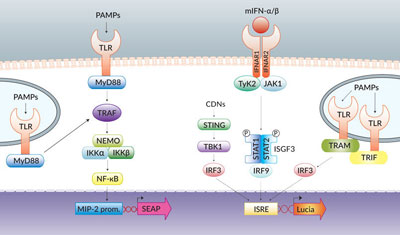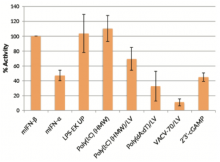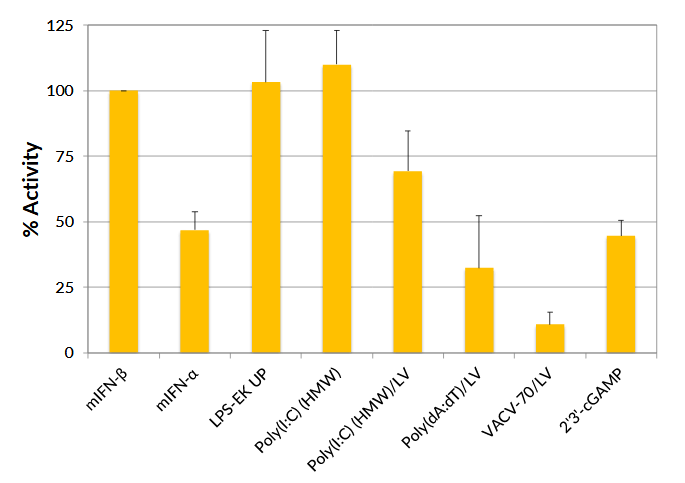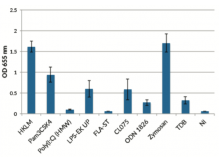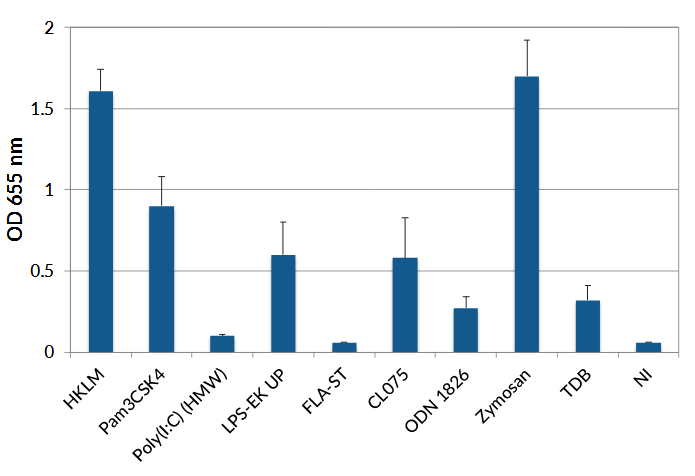RAW-Dual™ Cells
| Product | Unit size | Cat. code | Docs. | Qty. | Price | |
|---|---|---|---|---|---|---|
|
RAW-Dual™ Cells Dual IRF and MIP-2 (NF-kB) reporter mouse macrophages |
Show product |
3-7 x 10e6 cells |
rawd-ismip
|
|
Dual IRF-Lucia and MIP-2-SEAP murine macrophage reporter cell line
RAW-Dual™ (IRF-Lucia/KI-[MIP-2]SEAP) cells were generated from RAW 264.7 murine macrophages, which express many pattern recognition receptors (PRRs) such as the Toll-like receptors (TLRs) TLR2 and TLR4 [1], the cytosolic DNA sensor (CDS) cGAS [2], and the cyclic dinucleotide (CDN) sensor STING [2].
RAW‑Dual™ cells stably express two reporter genes encoding SEAP (secreted embryonic alkaline phosphatase) and Lucia luciferase.
SEAP expression depends on the activation of the endogenous MIP-2 promoter. MIP‑2, also known as CXCL2, is the murine homolog of human IL-8, a chemokine produced in an NF-κB-dependent manner [3]. The MIP-2 ORF has been replaced by the SEAP ORF using knockin technology. Hence SEAP expression reports activation of NF-κB.
The Lucia luciferase gene is under the control of an ISG54 minimal promoter in conjunction with five IFN-stimulated response elements (ISRE). It reports the activation of interferon regulatory factors (IRFs).
Both reporter proteins are secreted and readily measurable in the cell culture supernatant using QUANTI-Blue™ Solution, a SEAP detection reagent, and QUANTI-Luc™ 4 Lucia/Gaussia, a Lucia and Gaussia luciferase detection reagent. Alternatively, SEAP activity can be detected using HEK-Blue™ Detection, a cell culture medium allowing real-time detection of SEAP.
As a result, RAW-Dual™ cells allow to simultaneously study the NF-κB pathway, by assessing the activity of SEAP, and the IRF pathway, by monitoring the activity of Lucia luciferase.
RAW-Dual™ Cells are resistant to Zeocin®.
References:
1. Underhill DM. et al., 1999. The Toll-like receptor 2 is recruited to macrophage phagosomes and discriminates between pathogens. Nature. 401:811-5.
2. Hornef MW. et al., 2003. Intracellular Recognition of Lipopolysaccharide by Toll-like Receptor 4 in Intestinal Epithelial Cells. J Exp Med.198:1225-35.
3. Tanaka Y. & Chen ZJ., 2012. STING specifies IRF3 phosphorylation by TBK1 in the cytosolic DNA signaling pathway. Sci Signal. 5(214):ra20.
4. Kim DS. et al., 2003. NF-kappaB and c-Jundependent regulation of macrophage inflammatory protein-2 gene expression in response to lipopolysaccharide in RAW 264.7 cells. Mol Immunol. 40(9):633-43.
Specifications
Antibiotic resistance: Zeocin®
Quality Control:
-
The biallelic replacement of the mouse MIP-2 (also known as CXCL2) gene with the SEAP reporter gene was verified by PCR and sequencing.
The inability to produce MIP-2 has been confirmed by ELISA. - Reporter activity has been verified by functional assays.
- Cell line stability for 20 passages following thawing has been verified.
-
RAW-Dual™ cells are guaranteed mycoplasma-free.
This product is covered by a Limited Use License (See Terms and Conditions).
Back to the topContents
- 3-7 x 106 of RAW-Dual™ cells in a cryovial or shipping flask
- 1 ml Zeocin® (100 mg/ml)
- 1 ml Normocin™ (50 mg/ml)
- 1 ml of QB reagent and 1 ml of QB buffer (sufficient to prepare 100 ml of QUANTI-Blue™ Solution, a SEAP detection reagent)
- 1 tube of QUANTI-Luc™ 4 Reagent, a Lucia luciferase detection reagent (sufficient to prepare 25 ml)
![]() Shipped on dry ice (Europe, USA, Canada, and some areas in Asia)
Shipped on dry ice (Europe, USA, Canada, and some areas in Asia)





